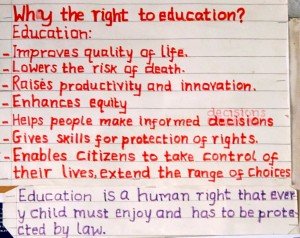NWPS

Handwritten posters cover nearly every wall in the teacher’s lounge. This one caught the eye of Maria Davis and Kristen Barr for the power of its message.
• Please visit the NWPS Campus Gallery for a photo tour of the school.
• Meet the NWPS Educators here.
• See the NW movie here.
Education in Kenya
Kenya began a campaign for free, primary education after independence in 1963. Since then the system has undergone transformation twice. Since 1985, public education in Kenya has been based on an 8-4-4 system, with eight years of primary education followed by four years of secondary school and four years of college or university. Out of all children in Kenya about 85% attend primary school. 75% of those who complete primary school attend secondary school, and 60% of those who complete secondary school proceed to business and vocational institutions, national polytechnics, and public or private universities.
Primary Education
In 2003, education Primary education in Kenya became free and universal, but not compulsory. Children begin attending school at the age of 6 or 7 usually after completion of a year of kindergarten commonly known as Nursery School. The first class is known as Standard 1 and the last year as Standard 8. The school year at both the primary and secondary levels begins in January and ends in November with three school vacations in April, August and December. Most primary schools are day schools while those at the secondary level can be day or boarding. All public primary school pupils sit for the Kenya Certificate of Primary Education (KCPE) examination at the end of the year in Standard eight.
Secondary Education
Secondary schools in Kenya fall into three categories: government funded, harambee, and private. After taking the KCPE and successfully passing, government funded schools select students based on their scores with the highest being placed in the national schools. Those with average scores attend provincial or district schools. Private secondary schools in Kenya, most offering the British system, are generally expensive, offering students an alternative system with more luxurious facilities compared to public schools. At the end of four years (Form 1 – Form 4), students sit for the Kenya Certificate of Secondary Education exam. Students who manage a C+ qualify to do a degree course at the university, although limited space exist in Kenya’s 30 universities.
Vocational Schools and colleges
Certificate courses offered at these two or three year post secondary institutions include: Accounting, Business Education, Nursing, Teacher Training, Culinary Studies, Media, and Tourism.
Current Challenges
The pupil to teacher ratio in 2009 was 1:45. However, there are gross disparities within regions, the worst affected being the Arid/Semi-Arid Lands (ASALs), such as the Samburu region. Other challenges include:
- shortage of experienced teachers and teacher training programs in need of reform
- inadequacies in the provision of educational infrastructure, especially in ASALs
- inhibitive cultural practices
- scarcity of financial resources
- child labor
- high levels of poverty
- weaknesses in the management, deployment and development of teachers
Oversight
The Ministry of Education, Science, and Technology (MoEST) is responsible for the provision of administrative and professional services in education at the national, provincial, and district levels. In the field, there are Provincial Directors of Education, and District and Municipal Education Officers who are in charge of administration and supervision of education in their respective provinces, districts and municipalities.
Sources and Further Reading:
Kenya Institute for Curriculum Development
Wikipedia, the free encyclopedia


Leave a Reply
You must be logged in to post a comment.